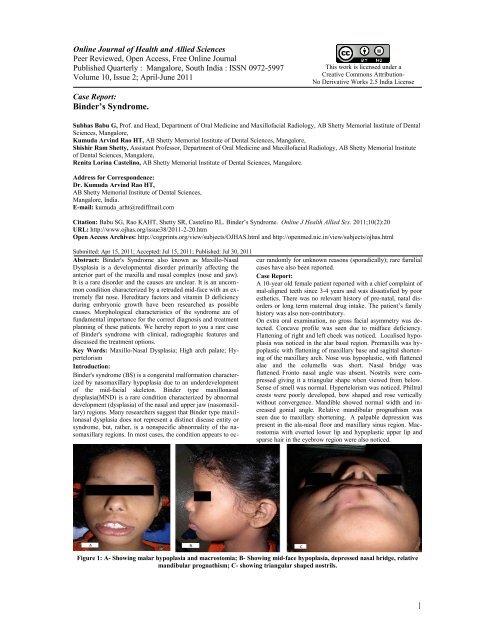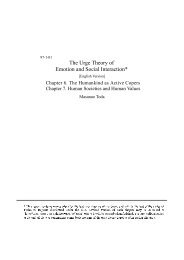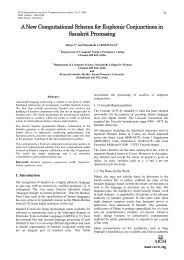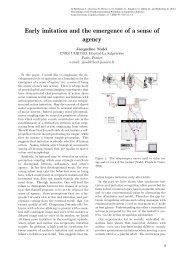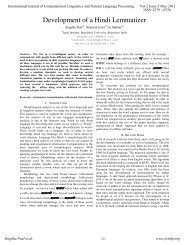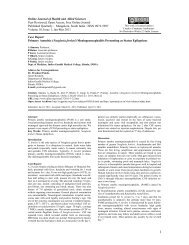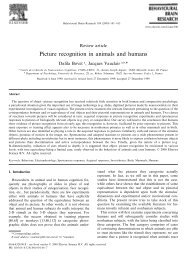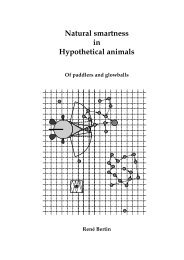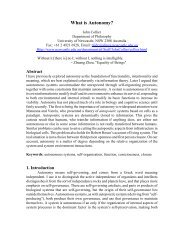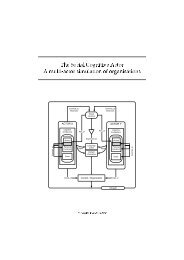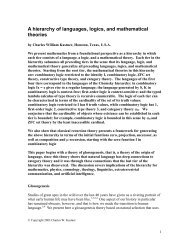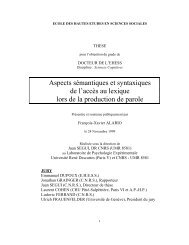Binder's Syndrome. - Cogprints
Binder's Syndrome. - Cogprints
Binder's Syndrome. - Cogprints
Create successful ePaper yourself
Turn your PDF publications into a flip-book with our unique Google optimized e-Paper software.
Online Journal of Health and Allied Sciences<br />
Peer Reviewed, Open Access, Free Online Journal<br />
Published Quarterly : Mangalore, South India : ISSN 0972-5997<br />
Volume 10, Issue 2; April-June 2011<br />
Case Report:<br />
Binder’s <strong>Syndrome</strong>.<br />
Subhas Babu G, Prof. and Head, Department of Oral Medicine and Maxillofacial Radiology, AB Shetty Memorial Institute of Dental<br />
Sciences, Mangalore,<br />
Kumuda Arvind Rao HT, AB Shetty Memorial Institute of Dental Sciences, Mangalore,<br />
Shishir Ram Shetty, Assistant Professor, Department of Oral Medicine and Maxillofacial Radiology, AB Shetty Memorial Institute<br />
of Dental Sciences, Mangalore,<br />
Renita Lorina Castelino, AB Shetty Memorial Institute of Dental Sciences, Mangalore.<br />
Address for Correspondence:<br />
Dr. Kumuda Arvind Rao HT,<br />
AB Shetty Memorial Institute of Dental Sciences,<br />
Mangalore, India.<br />
E-mail: kumuda_arht@rediffmail.com<br />
Citation: Babu SG, Rao KAHT, Shetty SR, Castelino RL. Binder’s <strong>Syndrome</strong>. Online J Health Allied Scs. 2011;10(2):20<br />
URL: http://www.ojhas.org/issue38/2011-2-20.htm<br />
Open Access Archives: http://cogprints.org/view/subjects/OJHAS.html and http://openmed.nic.in/view/subjects/ojhas.html<br />
Submitted: Apr 15, 2011; Accepted: Jul 15, 2011; Published: Jul 30, 2011<br />
Abstract: <strong>Binder's</strong> <strong>Syndrome</strong> also known as Maxillo-Nasal<br />
Dysplasia is a developmental disorder primarily affecting the<br />
anterior part of the maxilla and nasal complex (nose and jaw).<br />
It is a rare disorder and the causes are unclear. It is an uncommon<br />
condition characterized by a retruded mid-face with an extremely<br />
flat nose. Hereditary factors and vitamin D deficiency<br />
during embryonic growth have been researched as possible<br />
causes. Morphological characteristics of the syndrome are of<br />
fundamental importance for the correct diagnosis and treatment<br />
planning of these patients. We hereby report to you a rare case<br />
of <strong>Binder's</strong> syndrome with clinical, radiographic features and<br />
discussed the treatment options.<br />
Key Words: Maxillo-Nasal Dysplasia; High arch palate; Hypertelorism<br />
Introduction:<br />
<strong>Binder's</strong> syndrome (BS) is a congenital malformation characterized<br />
by nasomaxillary hypoplasia due to an underdevelopment<br />
of the mid-facial skeleton. Binder type maxillonasal<br />
dysplasia(MND) is a rare condition characterized by abnormal<br />
development (dysplasia) of the nasal and upper jaw (nasomaxillary)<br />
regions. Many researchers suggest that Binder type maxillonasal<br />
dysplasia does not represent a distinct disease entity or<br />
syndrome, but, rather, is a nonspecific abnormality of the nasomaxillary<br />
regions. In most cases, the condition appears to oc-<br />
This work is licensed under a<br />
Creative Commons Attribution-<br />
No Derivative Works 2.5 India License<br />
cur randomly for unknown reasons (sporadically); rare familial<br />
cases have also been reported.<br />
Case Report:<br />
A 10-year old female patient reported with a chief complaint of<br />
mal-aligned teeth since 3-4 years and was dissatisfied by poor<br />
esthetics. There was no relevant history of pre-natal, natal disorders<br />
or long term maternal drug intake. The patient’s family<br />
history was also non-contributory.<br />
On extra oral examination, no gross facial asymmetry was detected.<br />
Concave profile was seen due to midface deficiency.<br />
Flattening of right and left cheek was noticed. Localised hypoplasia<br />
was noticed in the alar basal region. Premaxilla was hypoplastic<br />
with flattening of maxillary base and sagittal shortening<br />
of the maxillary arch. Nose was hypoplastic, with flattened<br />
alae and the columella was short. Nasal bridge was<br />
flattened. Fronto nasal angle was absent. Nostrils were compressed<br />
giving it a triangular shape when viewed from below.<br />
Sense of smell was normal. Hypertelorism was noticed. Philtral<br />
crests were poorly developed, bow shaped and rose vertically<br />
without convergence. Mandible showed normal width and increased<br />
gonial angle. Relative mandibular prognathism was<br />
seen due to maxillary shortening. A palpable depression was<br />
present in the ala-nasal floor and maxillary sinus region. Macrostomia<br />
with everted lower lip and hypoplastic upper lip and<br />
sparse hair in the eyebrow region were also noticed.<br />
Figure 1: A- Showing malar hypoplasia and macrostomia; B- Showing mid-face hypoplasia, depressed nasal bridge, relative<br />
mandibular prognathism; C- showing triangular shaped nostrils.<br />
1
On intra-oral examination narrow, high arched, V-shaped palate<br />
was observed. Macroglossia was present. Patient presented with<br />
a class I malocclusion. Spacing was seen in relation to upper<br />
anteriors. The tooth eruption pattern appeared normal.<br />
Lateral cephalogram revealed hypoplastic anterior nasal spine<br />
and thinning of labial plate of the alveolar bone over upper incisors.<br />
The maxilla was retrognathic. The lower third face<br />
height was increased. The naso maxillary angle was increased.<br />
Cephalometric studies revealed increased gonial angle and proclination<br />
of incisors. Decreased anterior cranial base measurements,<br />
smaller maxilla vertically and antero-posteriorly were<br />
also noticed. Based on clinical and radiographic features, a diagnosis<br />
of Binder’s syndrome was arrived at.<br />
Figure 2: Showing macroglossia and high arch palate.<br />
Figure 3: Lateral cephalogram showing hypoplastic anterior<br />
nasal spine.<br />
Patient was referred for orthodontic and surgical evaluation for<br />
effective management.<br />
Discussion:<br />
The essential feature of MND was initially described by Noyes<br />
in 1939, although it was Binder who first defined it as a distinct<br />
clinical entity in 1962. 1 He reported on three cases and recorded<br />
six specific characteristics: Arhinoid face, abnormal position of<br />
nasal bones, inter-maxillary hypoplasia with associated malocclusion,<br />
reduced or absent anterior nasal spine, atrophy of nasal<br />
mucosa, absence of frontal sinus (not obligatory). 2 The ortho-<br />
dontists and surgeons are more closely associated with these<br />
patient’s due to the malocclusions and facial abnormalities, and<br />
the information regarding BS is very sparse in the literature.<br />
MND is a nonspecific abnormality of the nasomaxillary complex.<br />
The familial examples are a result of complex genetic<br />
factors, similar to those involved in producing a malocclusion.<br />
3 Although most cases involve only the nasomaxillary<br />
complex, a variety of other anomalies have been recorded including<br />
especially cervical vertebrae anomalies, but also various<br />
other skeletal defects, cardiac anomalies, orofacial clefting,<br />
strabismus, mental retardation, and other abnormalities. 4,5 However<br />
these features were not observed in our case. The affected<br />
patient’s show mid-face profile which is hypoplastic, flattened<br />
nose, convex upper lip with a broad philtrum, typically crescent<br />
or semi-lunar in shaped nostrils due to the short collumela, and<br />
a deep fold or fossa occurring between the upper lip and the<br />
nose, resulting in an acute nasolabial angle. 6 All but the last features<br />
were observed in our case.<br />
The maxilla was hypoplastic in both antero-posterior and vertical<br />
directions in early childhood and the latter showing some<br />
improvement with age. 7 This causes the feature of relative<br />
mandibular prognathism although mandibular length may be<br />
greater than normal, suggesting true prognathism in some<br />
cases. 8,9<br />
Binder believed that his patients had a mild form of arhinencephaly<br />
but there have been no reports of difficulties with the<br />
sense of smell to support this hypothesis. 2<br />
Similar facial features may be seen in other well defined conditions,<br />
including warfarin embryopathy, acrodysostosis, and<br />
Stickler's syndrome which may be included under differential<br />
diagnosis. It should be possible to distinguish each of these syndromes<br />
on the basis of additional historical and clinical features.<br />
10<br />
After assessment of the degree of facial bone abnormality, orthodontic<br />
and surgical procedures can be planned. 11 More<br />
severe cases require a Le Fort I or II osteotomy with nasal<br />
grafting. 12 As the degree of malformation in BS varies significantly,<br />
surgical correction needs to be individually tailored. 13<br />
Conclusion:<br />
The characteristics of the Binder’s syndrome are typically visible<br />
since a young age. It can also be present in combination<br />
with other malformations. In such severe cases, the syndrome<br />
requires combined orthodontic and surgical treatment to<br />
achieve an adequate facial profile.<br />
References:<br />
1. Noyes FB. Case report. Angle Orthod 1939;9:160–<br />
165<br />
2. Binder KH. Dysostosis maxillo-nasalis, ein archinencephaler<br />
Missbildungskomplex. Deutsche<br />
Zahnarztuche Zeitschift 1962;17:438–444.<br />
3. Gorlin R, Pindborg JJ, Cohen M Jr. Maxillonasal<br />
dysplasia (Binder syndrome). <strong>Syndrome</strong>s of the<br />
head and neck. 2nd ed. New York: McGraw-Hill;<br />
1976.<br />
4. Delaire J et al. clinical and radiographic aspects of<br />
maxillonasal dysostosis (Binder’s syndrome). Head<br />
Neck Surg 1980;3:105-122.<br />
5. Olow-Nordenram MA, Radberg CT. Maxillonasal<br />
dysplasia (Binder’s syndrome) and associated malformations<br />
of the cervical spine. Acta Radiol (Diagn)1984;25:353-360.<br />
6. Dyer FMV, Willmot DR. Maxillo-nasal dysplasia,<br />
<strong>Binder's</strong> syndrome: review of the literature and case<br />
report. Journal of Orthodontics. March<br />
2002;29(1):15-21,<br />
7. Horswell BB, Holmes AD, Levant BA, Barnett JS.<br />
Cephalometric and anthropomorphic observations<br />
of<strong>Binder's</strong> syndrome: A study of 19 patients. Plast<br />
Reconstr Surg 1988;83:325-335.<br />
2
8. Olow-Nordenram M. Masillonasal dysplasia<br />
(<strong>Binder's</strong> syndrome). A study of craniofacial morphology,<br />
associated malformations and family relations.<br />
Swted Dent J [Suppl] 1987;47:1-38.<br />
9. Munro IR, Sinclair WJ, Rudd NL. Maxillonasal dysplasia<br />
(<strong>Binder's</strong> syndrome). Plast Reconstr<br />
Surg 1979;63:657-663.<br />
10. Quarrell OWJ, Koch M, Hughes HE. Maxillonasal<br />
dysplasia (<strong>Binder's</strong> syndrome). Med Genet<br />
1990;27:384-387.<br />
11. Rintala A, Ranta R. Nasomaxillary hypoplasia-<strong>Binder's</strong><br />
syndrome. Scand J Plast Reconstr<br />
Swrg 1984;19:127-134.<br />
12. Holstrom H. Surgical correction of the nose and<br />
midface in maxillonasal dysplasia (<strong>Binder's</strong> syndrome).<br />
Plast Reconstr Surg 1986;78:568-580.<br />
13. Bhatt YC, Vyas KA, Tandale MS, Panse NS, Bakshi<br />
HS, Srivastava RK. Maxillonasal dysplasia (<strong>Binder's</strong><br />
syndrome) and its treatment with costal cartilage<br />
graft: A follow-up study. Indian J Plast Surg. 2008<br />
Jul;41(2):151-159.<br />
3


